An interview with Margaret Atwood
The literary icon discusses her career-spanning poetry collection, Paper Boat
Before the best-selling, award-winning novels, for Margaret Atwood, there was poetry.
As the legend goes, she was first carried into the woods via packsack at six months old (her surname is derived from “atter wode”, meaning “pearl of the woods”). Owing to her father’s career as a forest entomologist, the Atwood family would arrive to the wilds of Northern Quebec in early spring, only returning to civilization in the late autumn, once the snow began to fall.
“This landscape became my hometown,” writes Atwood in Negotiating with the Dead: A Writer on Writing, one of the more than fifty books in her canon. Her mother, a dietician, would educate the children (Atwood has an older brother and younger sister) with work books borrowed from school. In a 2017 interview with The New Yorker, Atwood remembers, “The faster you could do them, the sooner you could go out and play, so I became very rapid and superficial in my execution of those sorts of things.” Exploration was encouraged—Atwood’s father would lead his children through the woods, examining insects and plants; one can imagine how this education sharpened Atwood’s poetic eye.
It was at the Bohemian Embassy coffeehouse, in an old building off Toronto’s Yonge Street, in 1960 that Atwood gave her first public reading. The room was typically dark and smoke-filled, the only light coming as an intrusive blast each time someone opened the bathroom door. Poets’ voices struggled to match the espresso machine, rumoured to be the first in Toronto. Atwood once likened it to baptism by fire—the only place in the city where poets could read to an audience (Gwendolyn MacEwen also cut her teeth at the Embassy). “Once you'd done that, you were kind of ready for everything.”1
Double Persephone, Atwood’s first collection, was handset on a flatbed press in 1961, the cover printed by linoblock, selling for fifty cents; under two hundred copies were made: these are the poems which will greet readers in the first pages of Paper Boat.
The Circle Game arrived in 1966, winning the Governor General’s Award, Canada’s only big literary prize of the time—an unexpected, albeit thrilling success for the young poet. After that: Atwood’s first novel, The Edible Woman. In the 1970s, works of poetry, fiction and critical essays were published in quick succession: The Journals of Susanna Moodie, Procedures for Underground, Power Politics, You Are Happy, and Surfacing, as well as Survival: A Thematic Guide to Canadian Literature. As the years progressed Atwood’s canon (and literary star status) grew: Life Before Man, Cat’s Eye, Alias Grace, The Testaments. She has authored children’s books and graphic novels, is known worldwide for her best-selling and critically acclaimed novel The Handmaid’s Tale, which has been translated into over forty languages and was adapted into a popular television series. For one of the most prolific and revered literary figures of our time, fiction is often born from the poetic: “Most of [my novels] have begun with seeds planted first in poems,” she tells me.
As a teenager, Margaret Atwood was my introduction to poetry. In English class when we read The Handmaid’s Tale, I was struck by its poetic licence: Nothing moves in the searchlight moon. The scent from the garden rises like heat from a body, there must be night-blooming flowers, it’s so strong. I can almost see it, red radiation, waving upwards like the shimmer above highway tarmac at noon. The English literature teacher introduced me to Mad Shadows by Marie-Claire Blais; the thread between these two authors encouraged me to delve deeper into Canadian literature. In the library’s poetry section, I found Miriam Waddington, Susan Musgrave—and more Margaret Atwood. The poems, underlined, memorized, and in some cases never returned to the library, nurtured my own creativity.
Growing up on a farm in the days of low-speed, dial-up internet, in a rural area of Southern Ontario where the bus ride to school was close to an hour each way, I had plenty of time to read. Life then was measured in distances: from our house to town, our house to school. I knew every bump in the two-lane highway and backroads. In summer, lush fields thrummed like green oceans. The landscape, dotted with old farmhouses like the one I grew up in, felt as though it belonged to another era. I also measured life by seasons: during the springtime, sheep moved in amoebic waltzes across the rolling hills. During winter, the wind snaked across hardened mounds of earth where crop once grew, ghosts travelling in silent procession. It was through Atwood’s poetry that I developed a language for what I saw and felt there.
At eighteen, when I graduated high school and moved to Toronto, my personal library multiplied like an invasive species. I visited any and every used bookstore, collecting whichever volumes were on offer: You Are Happy, Two-Headed Poems, her Selected Poems 1966-1984 and Selected Poems II 1976 - 1986. These collections were at once urgent and evocative, alive with the poet’s spellbinding ability to observe, imagine, record, transfuse.
Over the course of working on this interview, I’ve asked myself why Atwood’s poems resonate with me so deeply. It extends beyond merely reading her in high school: I lived not far from the farm where she and her husband, the writer Graeme Gibson, produced novels like Alias Grace and Perpetual Motion. I think of a poem like “The Surveyors”, which describes the diffused weight of summer. The full moon, oval and gentle, the sun, the snow, the cedar groves, the ragweed, the frogs with their dud guitar-string throats… The roads she writes about are ones I’ve travelled hundreds of times; I could relate to the images in her poems because I had encountered them myself—her seasons were my seasons. Her language was not merely an escape, but an incision—a surgery—into (and of) the everyday. Deconstruction, she writes, shines with such beauty2.
There is no easy way to summarize Atwood’s poetic canon. Diverse as they are in both theme and form, the poems share a single commonality: they move the reader. A teenage girl in the rural countryside may be reading poems from The Journals of Susanna Moodie—a groundbreaking collection written from the perspective of an English settler whose life in the backwoods of Ontario during the 1830s inspired the famous Canadian memoir, Roughing it in the Bush—but lines like I am a word / in a foreign language or the air / was about to tell me / all kinds of answers are universal.
It’s not as though a poet can remove their uniform or clock out at the end of the day—they possess a constant awareness of the world around them. From “Four Small Elegies”: A language is not words only, / it is the stories / that are told in it, / the stories that are never told. To read the poems in Paper Boat, then, is to delve into a life of keen observation. Through these pages, Atwood navigates the complexities of love, history, identity, and death with an exactitude that only she can conjure. Marge Piercy once described Atwood’s poems as having the power to “explain to you why and how you are dying and help keep you alive.” Paper Boat is a portal: enter if you dare, there is no telling where you’ll end up.
Though the collection spans from the beginning of her career with Double Persephone, to her latest work—including the title poem—from 2023, this is not the definitive collection of Atwood’s life as a poet. As she will tell in this interview, “There’s much moooore….” In a message to the reader in Paper Boat’s acknowledgements, Atwood imparts: “Writing passes from hand to hand, and if you are reading this, my writing is now in your hands. To paraphrase a great aphorist, the spirit blows wherever it wishes. I hope you don’t find it an ill wind.”
Whether you are an ardent reader of all things Atwood, or are new to her oeuvre, you will find that Paper Boat is a remarkable volume by a poet who has seemingly always been at the height of her powers. These poems will entrance you. Stop you in your tracks. Encourage you, as Atwood’s father did, to look closer: the true story is vicious. Perhaps you will write a poem of your own. Perhaps you will not. One thing, through the histories and romances, the decay and the light of these poems, remains certain: wherever Margaret Atwood leads, we will follow.
What is your earliest memory of—or what was your first introduction to—poetry? When did you first feel ready to share your poems with an audience?
Do you mean poetry of any kind, or modern poetry?
If of any kind, then Mother Goose Nursery Rhymes, which has some very surreal pieces in it – intriguing for a child of five. In the same vein, I wrote a booklet of such poems at age 6. If you mean more serious poetry – we had poetry in school, and we memorized poems, and learnt rhyme schemes and scansion, but I wasn’t galvanized by poetry until age 16. I seem to have had little hesitation about making it public, since I published it in the school magazine and continued in the college magazine, making the leap to non-school publications when I was 19 or 20 – using “M.E. Atwood” as my nom de plume, so no one would know I was a girl. Not a slam dunk, being a female poet at that time. ”Poetess” was a slur. Meant you weren’t a real poet.
In your experience, how does writing poetry differ from writing fiction?
It’s my unproven belief that different parts of the brain are involved: the parts closer to music and math for lyric poetry, the parts closer to ordinary speech and story-telling for fiction. (Narrative poetry is another matter.) But all art involves patterns: repetitions with variations. Lyric poems are typically short, so the pattern-making elements are closer together. Think of waves: ripples vs tsumamis.
“The whole book is a paper boat.” —Margaret Atwood
Can you share what the title of this collection, Paper Boat, means to you?
It’s the title of one of the later poems in the book. Apart from that, the real question is: what will the title mean to the reader? Those two words have opposed meanings: paper, flimsy and unreliable. Boat, strong, keeps you afloat. But can sink. Paper, what you write poems on. Boat, a means of voyaging. Also, paper boats used to be launched by children to float down streams… Is a paper boat like a message in a bottle that will come ashore far away from the person who sent it out? Like, for instance, books…
In the poem, the voyage is more like a trip from an earlier time to a much riskier present. But that’s the poem, not the book. The whole book is a paper boat. Hey – that’s what it says in the cover warning. May contain poems.
What advice (life, career, or otherwise) might the Margaret Atwood of today offer to the twenty-year-old Margaret who first read her poems at the Bohemian Embassy?
I’m not sure I have any advice, apart from: a) learn to touch-type, and b) do back exercises. You can’t really give people general advice about writing. It’s Learn By Doing. You can give advice about individual pieces (“Put that word here”) but that’s a different thing.
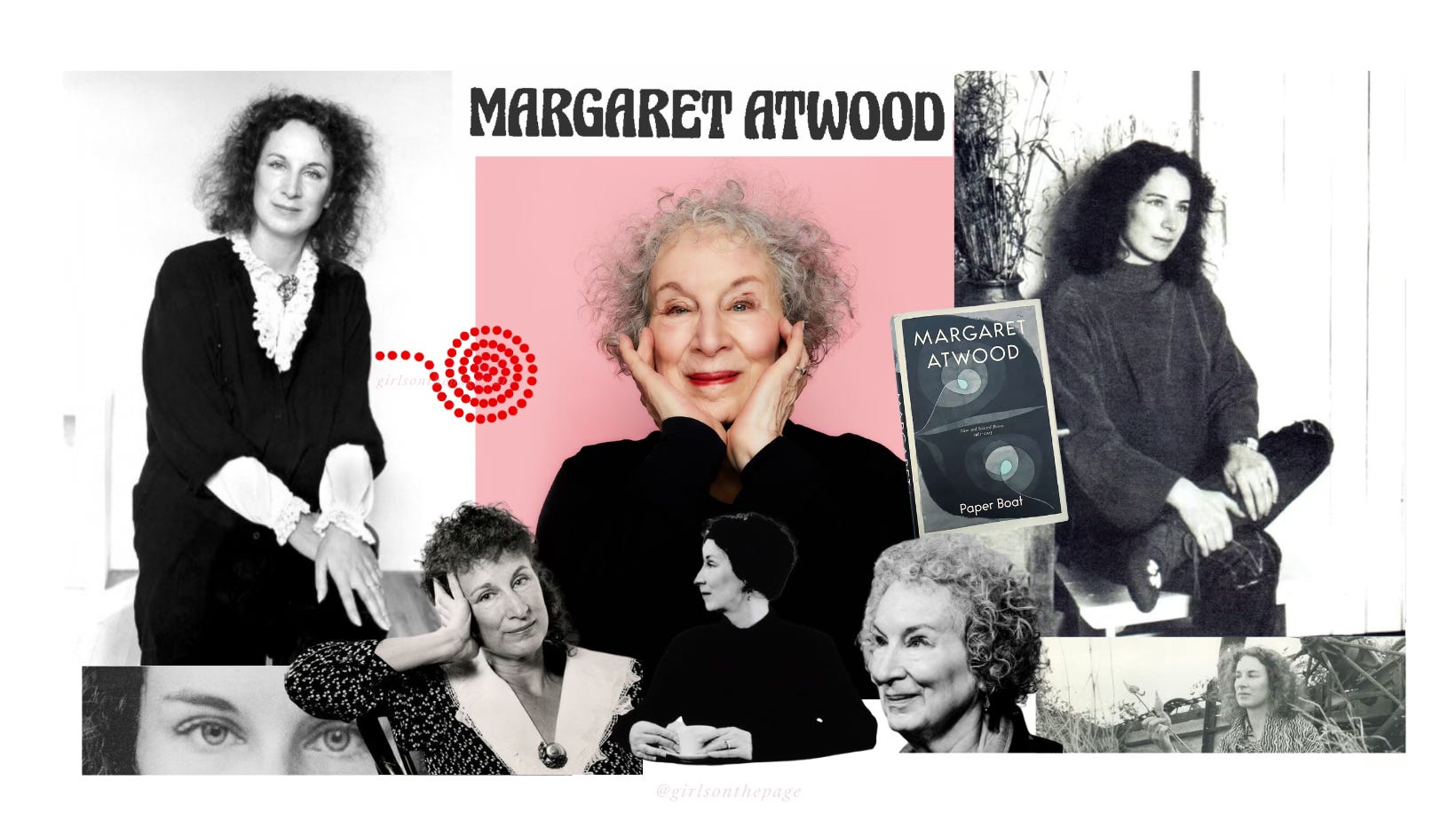
Can you share with us how a poem arrives—what does inspiration look or feel like for you, how do you know when to follow an image, a word, an idea?
There is no way of describing this, except to say that it’s irritating for other people when you’re looking out the window and they say “Help me mow the lawn” and you say “I’m working.”
Poems always begin with a cluster of words, and are heard before they are seen. Writing is writing down.
Conversely, are you able to “turn off” the part of your brain which observes, overhears, gleans inspiration—or are you always picking up tidbits, storing them away for poems, characters, novels? How does your writer/poet-self behave when away from the desk and grocery shopping, for instance?
All writers have more than one self. As for my “mind,” it’s like Grandmother’s attic – all sorts of stuff in there, but you never know when it might come in handy. If ever.
In the acknowledgements you mention the “arid period” before the reinvention of Canadian publishing in the sixties and seventies, writing “…thinking you could be a writer, in the Canada of the late fifties and early sixties, was like pushing a huge boulder up a hill”. What encouragement do you have for the writers and poets of today who are starting out—how has the literary landscape changed?
There are tons more writers now. But that means there’s tons more competition, too.
Poets in all generations tend to start in coteries or groups, and begin by self-publishing. There are a lot more ways to do that now… and there are more public venues and occasions for reading work out loud. But as I say, many more doing it.
Poetry was such a major form in Canada in the 60s because it was so hard to publish novels. Poetry was cheap to produce. Not so many pages. :)
“All writers have more than one self. As for my “mind,” it’s like Grandmother’s attic – all sorts of stuff in there, but you never know when it might come in handy. If ever.”
—Margaret Atwood
In its 550+ pages, Paper Boat represents the immense contribution that you have made to the world of poetry. This collection will be a wonderful way for new readers to become familiar with your work, and for long-time readers to have almost all of your poems in one place. You have given a life to poetry—I’m curious, what has poetry given you in return?
I’m sorry to say that it’s not “almost all.” There’s much moooore….
What does poetry give in return:
1. Itself. The moment. The flow, the total focus…
Novels and stories. Most of mine have begun with seeds planted first in poems.
The sheer delight of tangling and untangling language itself. Our complex languages are probably the first fully human technologies invented. “I think, therefore I am” might really be “I speak, therefore I am.” Or possibly, “I sing, therefore I am.” Poetry and singing are joined at the hip.
Your Substack, “In the Writing Burrow”, is an entertaining, thoughtful space where you share personal updates and anecdotes, even a serialized history of the French Revolution. I grew up down the road from the farm you wrote about in the newsletter titled “Three Domestic Fowl Tragedies”. For my own curiosity, I’d love to know which poems you wrote during this period, if any were directly influenced by your time living in the area?
How interesting. Where, exactly, did you grow up “down the road”?
The 70s, during which we lived there and farmed (however badly), was probably the last decade during which that rural line operated as a predominantly small-farming community. The farmers then retired, and the kids didn’t want to continue; or the farmers lost their farms to banks via high interest rates. The farm houses became weekend houses. It was beyond fascinating – in retrospect – to have lived through that period, though there was always some catastrophe or other about to happen. As is usual on farms. (“The cows got out! Again!”)
The influences of that time were profound, for both Graeme Gibson (Perpetual Motion) and me (Alias Grace, part of Robber Bride, and a bunch of stories, especially in Moral Disorder). As for poetry, I wrote quite a lot of it then. Anything with sheep in it, anything with chickens in it, anything with wild plums in it… Anything with ghosts: we had one. Digging, gardening; those have other locations in my life as well, but I ran a gigantic vegetable garden at the farm. Everything in it. Including slugs. Anything with slugs in it.
When we moved onto the line, we were the newest family. When we moved off, a mere nine years later, we were the oldest. The daffodils I planted along the front were still going strong, the last time I looked.
MARGARET ATWOOD is the author of more than fifty books of fiction, poetry, and critical essays. She has won the Booker Prize, the Arthur C. Clarke Award for Imagination in Service to Society, the Franz Kafka Prize, the Peace Prize of the German Book Trade, the PEN USA Lifetime Achievement Award, and the Dayton Literary Peace Prize. She lives in Toronto, Canada.
Paper Boat: New and Selected Poems 1961-2023 is available everywhere books are sold.
Interview by Emma Leokadia Walkiewicz
For inquiries — girlsonthepageclub@gmail.com
From the poem “Newsreel: Man and Firing Squad”


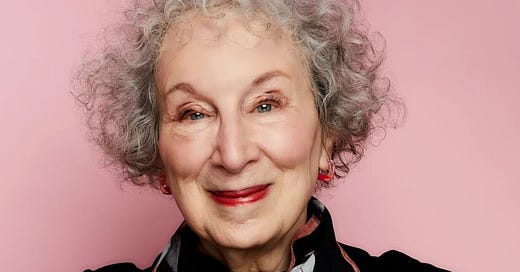



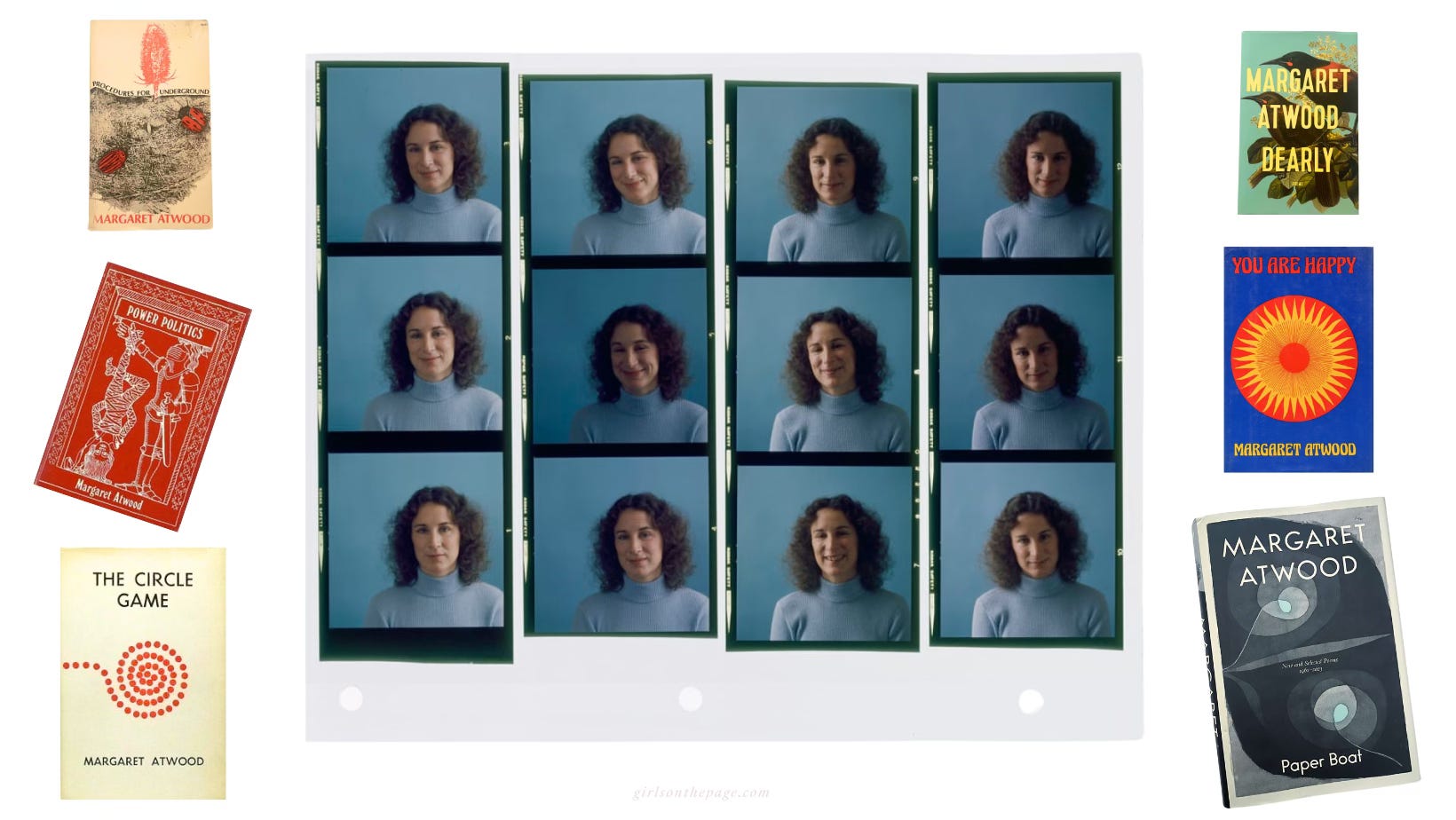
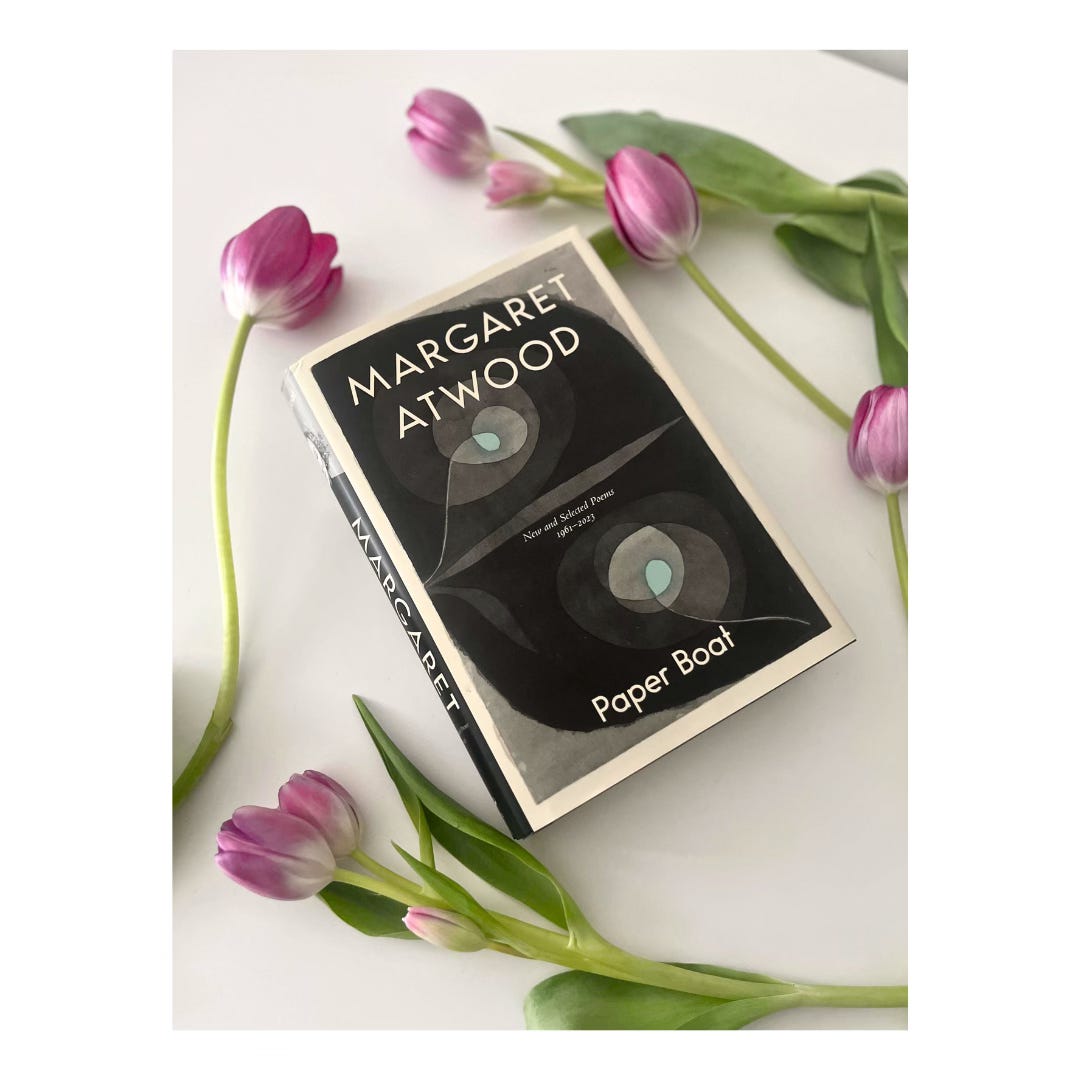
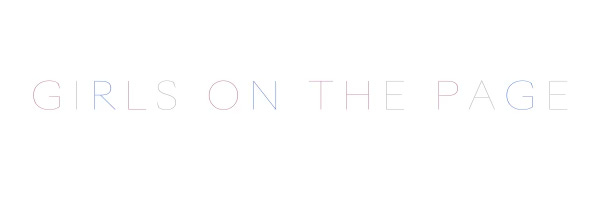
Wow! Congratulations, Emma. What a wonderful interview. Thank you both for sharing it with us.
This interview and it's beautiful introduction were nothing short of magical. My favorite post of yours yet! - Not to mention a magically compelling interview with the legend herself. Absolutely fantastic.